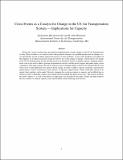Crisis Events as a Catalyst for Change in the US Air Transportation
Author(s)
Mozdzanowska, Aleksandra; Hansman, R. John
Downloadalexm-ITCPI-2007.pdf (1.163Mb)
Metadata
Show full item recordAbstract
Historically, aircraft accidents have preceded the implementation of many changes in the US Air Transportation
System. These accidents act as catalytic events which generate awareness of a problem and pressure for change to occur.
Specifically, aircraft accidents indicate the presence of safety problems. As past safety problems were addressed
the frequency of accidents decreased causing new drivers for system change to emerge. Current drivers for change
in the US Air Transportation System include increases in demand in the face of limited capacity, emerging requirements
such as the need to address growing environmental concerns, and the need to replace and update aging system
components. This paper explores the role of catalytic events in bringing change to the US Air Transportation System
with a focus on the implications for capacity driven change. In order to address capacity constraints, infrastructure
improvements, such as construction of new runways, or efficiency improvements, which would allow aircraft to be
spaced closer together, can be made. However, changing the system in response to capacity can be difficult due to
barriers posed by stakeholder conflicts and complex decision making and approval processes. The capacity problem,
the need to address it, as well as the barriers to addressing it are presented in this paper. Finally, the paper explores
the role of delays as catalytic capacity events and the likely actions following such an event.
Date issued
2007-07Citation
A. Mozdzanowska, R.J. Hansman, "Crisis Events as a Catalyst for Change in the US Air Transportation System - Implications for Capacity", In Proceedings of the 10th International Conference on Technology Policy and Innovation. Stavanger, Norway. June 2007. Awarded Best Paper.
Keywords
aircraft accidents, safety, Air Transportation, policy